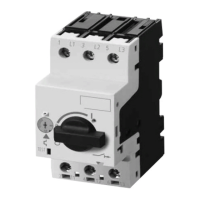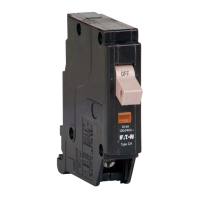I.B. 32-255-1G
Page 29
Effective 12/02
been made while the circuit breaker is levered to the
CONNECTED position.
When the CS/C contact is made, the SR closes the cir-
cuit breaker. If the CS/C contact is maintained after the
circuit breaker closes, the Y relay is picked up. The Y/a
contact seals in Y until CS/C is opened. The Y/b contact
opens the SR circuit, so that even though the circuit
breaker would subsequently open, it could not be
reclosed before CS/C was released and remade. This is
the anti-pump function.
5-4.1 TIMING
The opening and closing times for the circuit breakers
vary depending upon the control voltage and the power
rating. Typical values for VCP-W outdoor breaker ele-
ments are shown in Table 5.2.
5-4.2 SECONDARY DISCONNECTS
The circuit breaker control wiring is arranged to connect
a standard 25 point male plug with a corresponding
switchgear compartment mounted female plug. The cir-
cuit breaker plug is fixed mounted on the left side under
the bottom pan of the mechanism (Figure 4-4). The
female plug is mounted in the compartment on a mov-
able carriage (Figure 4-2).
The secondary disconnects engage automatically as the
circuit breaker is levered into the CONNECTED posi-
tion, and disengage as the circuit breaker is withdrawn
from the CONNECTED position. To engage the sec-
ondary contacts while the circuit breaker is in the TEST
position, raise the handle and pull the carriage all the
way towards the front (Figure 4-5). This will latch the
contacts. To disengage the contacts, simple push the
carriage to the rear.
5-4.3 UNDERVOLTAGE TRIP DEVICE
The undervoltage trip device for VCP-W circuit breakers
is an electromechanical device that operates to open
the circuit breaker at 30% or less of the voltage rating of
the trip coil. The device does not open the circuit break-
er at values above 60% of the voltage rating of its trip
coil. It may operate, however, to open the circuit breaker
when the voltage across the trip coil is greater than
30%, but less than 60% of the voltage rating of its trip
coil. The circuit breaker can be closed as long as the
voltage to the trip coil is maintained at 85% or above the
rated level. The undervoltage trip device is available
only as an instantaneous type with rated voltages of
48VDC, 125VDC, 250VDC, 120VAC and 240VAC.
For a basic understanding of the operation of the under-
voltage trip device refer to the specific items identified in
Figure 5-6 and the following operation description.
1. With the circuit breaker closed and sufficient voltage
on the Undervoltage Trip Device coil, the moving
clapper (1) is held to the stationary yoke (2) by the
magnetic force produced by the coil (3) against the
extension springs (4) pulling the moving clapper
apart from the yoke.
2. The moving clapper is connected to the mechanism
Trip D Shaft Lever (5) by a slotted link (6).
3. When the voltage to the Undervoltage Trip Coil goes
down as described earlier, the extension springs
force overcomes the reduced magnetic force and
pulls the moving clapper up. The slotted link in turn
upsets the Trip D Shaft and the circuit breaker trips
open.
4. As the circuit breaker opens, the reset lever (8) con-
nected to the pole shaft lever (7) operates to reset
the moving clapper. As long as the circuit breaker
remains open, the reset lever holds down the moving
clapper to the yoke.
5. When the circuit breaker closes, the reset lever
moves away from the moving clapper. If the Under-
voltage Trip Device coil has at least 85% of the rated
voltage applied, the moving clapper is held to the
yoke by the magnetic force, even though the reset
lever has moved up.
Event Milliseconds (maximum)
Closing Time
(From Initiation of Close 45-60
Signal to Contact Make)
Opening Time
(Initiation of Trip Signal 30-45
to Contact Break)
Reclosing Time
(Initiation of Trip Signal 140-165
to Contact Make)
Table 5.2 Circuit Breaker Timing

